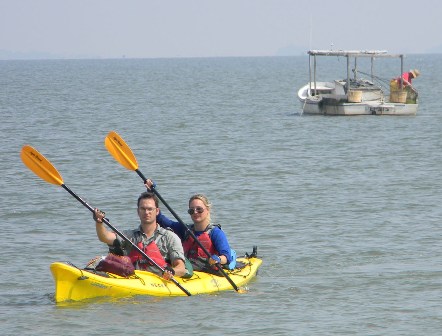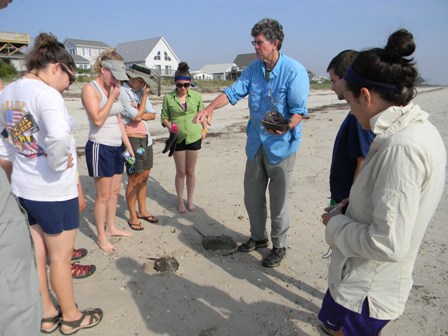SU Students Kayak the Chesapeake in Experiential Learning Class
Friday, June 24, 2011
SALISBURY, MD---No computers. No iPods. No cell phones. No television. How does a Salisbury University student survive?
Quite well, actually, according to the participants of SU’s recent “Exploring Delmarva: A Water’s-Eye View,” a first-of-its-kind experiential learning class offered as part of the University’s Environmental Studies Program.
Co-founded by faculty members Tom Horton and Bill Nelson, the five-week class included a month-long kayak tour of the Chesapeake Bay. During the course, students often camped in the wilderness of the Delmarva Peninsula and spent their days meeting area watermen, wildlife authorities and conservation experts who explained how the bay contributes to their livelihoods, as well as the overall ecosystem—nearly 50 conversations in all.
The idea came about as he recounted circumnavigating the waterway in celebration of his 60th birthday. He and Nelson worked to condense the month-long trip into a “best of the Chesapeake” tour that students could complete in 20 days, taking breaks only to go home on weekends.
“We were talking about how we would like more truly experiential programs for environmental science students,” said Nelson.
Students said the class more than met that goal.
“It was definitely hands-on,” said Sarah Mattingly, a senior environmental science major from Annapolis. “We packed the kayaks. We cooked. We camped out.” And perhaps most importantly, the organizers “wanted our input. They wanted to know how to make this even better in the future.”
From planting eel grass in Virginia with the Nature Conservancy as part of the largest restoration project of its kind to learning about old growth forests from author and SU professor Dr. Joan Maloof to discussing environmental policy with former Congressman Wayne Gilchrest, the class offered many unique opportunities.
Students met members of the Nanticoke Native American tribe, visited watermen and trappers on Smith and Tangier islands, and learned about marine life at the University of Maryland Center for Environmental Science’s Horn Point Laboratory, a National Oceanic and Atmospheric Administration laboratory and at the Virginia Institute of Marine Science.
They also camped out among wild ponies at Assateague Island Nationa
 l Seashore, spent time at Cape Henlopen State Park and visited the remains of the rapidly disappearing Holland Island, as well as the Virginia barrier islands. SU faculty and administration, including Dr. Michael Lewis, director of the Environmental Studies Program, and Dr. Maarten Pereboom, dean of the Charles R. and Martha N. Fulton School of Liberal Arts, joined them for portions of the class.
l Seashore, spent time at Cape Henlopen State Park and visited the remains of the rapidly disappearing Holland Island, as well as the Virginia barrier islands. SU faculty and administration, including Dr. Michael Lewis, director of the Environmental Studies Program, and Dr. Maarten Pereboom, dean of the Charles R. and Martha N. Fulton School of Liberal Arts, joined them for portions of the class.“It was almost like a study abroad experience,” said Alison Mattingly, a senior environmental studies and history major, and Sarah’s sister.
Indeed, the immersion was modeled after SU’s study abroad program. Several students said the inaugural trip was transformative.
“Before this course, I wasn’t sure what to do with my major,” said senior environmental studies major Lisa Barry of Grasonville, MD. “I wanted to see the different career paths. I never thought I would want to teach at all. Now, I think I would like to teach, even as a volunteer, especially young kids.”
Meeting the bay’s environmental and folkway experts, and working closely with Horton, an award-winning author and environmental writer with The Baltimore Sun for more than two decades, sparked a different interest in Jessica Hoffmaister, a junior communication arts major from Rockville, MD.
“The trip made me realize that I like meeting and talking to people,” she said. “I’m changing my concentration from media studies to journalism and public relations because that is what I want to do now. I want to be a reporter.”
Students wrapped up the five-week adventure by working with Dr. Andrew Sharma of the Communication Arts Department faculty to prepare presentations about what they learned during the trip. The class also i
 nspired several senior seminar projects, which students hope to work on in the coming year.
nspired several senior seminar projects, which students hope to work on in the coming year.For all the days spent lugging the 90-pound kayaks and swatting mosquitoes, the 10 participants had surprisingly few complaints. In fact, they are hoping to form a club so they and other like-minded students can further explore the environment up close.
“Nothing beats camping, and looking up and seeing the stars,” said Sarah Mattingly. “Going to sleep with the sunset, with the pelicans flying by, it almost seemed fake, like something out of a movie.”
Except it wasn’t. Instead, it was a production played out on the biggest screen of all: the outdoors.
For more information call 410-543-6030 or visit the SU Web site at http://www.salisbury.edu/.
Salisbury University Press Release
No comments:
Post a Comment